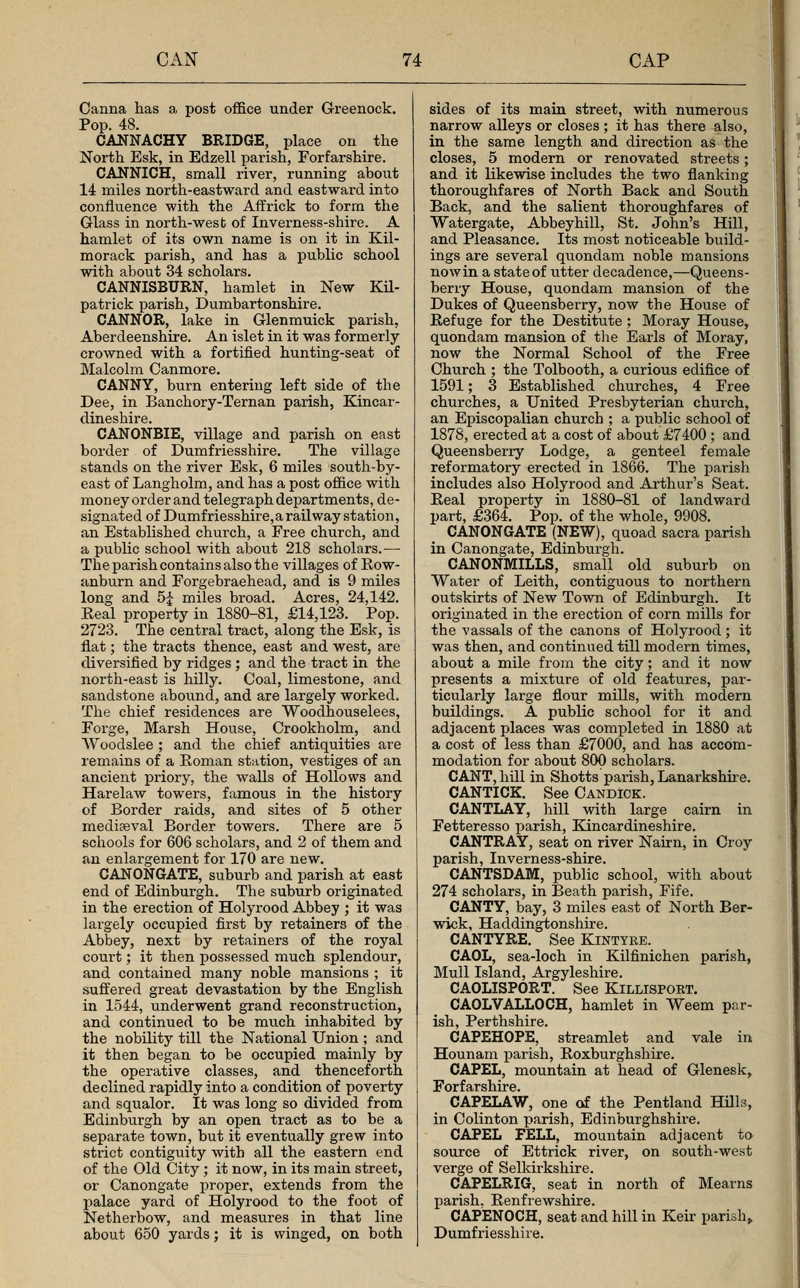CANNACHY BRIDGE, place on the North Esk, in Edzell parish, Forfarshire.
CANNICH, small river, running about 14 miles north-eastward and eastward into confluence with the Affrick to form the Glass in north-west of Inverness-shire. A hamlet of its own name is on it in Kilmorack parish, and has a public school with about 34 scholars.
CANNISBURN, hamlet in New Kilpatrick parish, Dumbartonshire.
CANNOR, lake in Glenmuick parish, Aberdeenshire. An islet in it was formerly crowned with a fortified hunting-seat of Malcolm Canmore.
CANNY, burn entering left side of the Dee, in Banchory-Ternan parish, Kincardineshire.
CANONBIE, village and parish on east border of Dumfriesshire. The village stands on the river Esk, 6 miles south-by-east of Langholm, and has a post office with money order and telegraph departments, designated of Dumfriesshire, a rail way station, an Established church, a Free church, and a public school with about 218 scholars. The parish contains also the villages of Rowanburn and Forgebraehead, and is 9 miles long and 5f miles broad. Acres, 24,142. Real property in 1880-81, 14,123. Pop. 2723. The central tract, along the Esk, is flat ; the tracts thence, east and west, are diversified by ridges ; and the tract in the north-east is hilly. Coal, limestone, and sandstone abound, and are largely worked. The chief residences are Woodhouselees, Forge, Marsh House, Crookholm, and Woodslee ; and the chief antiquities are remains of a Roman station, vestiges of an ancient priory, the walls of Hollows and Harelaw towers, famous in the history of Border raids, and sites of 5 other mediaeval Border towers. There are 5 schools for 606 scholars, and 2 of them and an enlargement for 170 are new.
CANONGATE, suburb and parish at east end of Edinburgh. The suburb originated in the erection of Holyrood Abbey ; it was largely occupied first by retainers of the Abbey, next by retainers of the royal court ; it then possessed much splendour, and contained many noble mansions ; it suffered great devastation by the English in 1544, underwent grand reconstruction, and continued to be much inhabited by the nobility till the National Union ; and it then began to be occupied mainly by the operative classes, and thenceforth declined rapidly into a condition of poverty and squalor. It was long so divided from Edinburgh by an open tract as to be a separate town, but it eventually grew into strict contiguity with all the eastern end of the Old City ; it now, in its main street, or Canongate proper, extends from the palace yard of Holyrood to the foot of Netherbow, and measures in that line about 650 yards; it is winged, on both sides of its main street, with numerous narrow alleys or closes ; it has there also, in the same length and direction as the closes, 5 modern or renovated streets ; and it likewise includes the two flanking thoroughfares of North Back and South Back, and the salient thoroughfares of Watergate, Abbeyhill, St. John's Hill, and Pleasance. Its most noticeable buildings are several quondam noble mansions now in a state of utter decadence, Queensberry House, quondam mansion of the Dukes of Queensberry, now the House of Refuge for the Destitute ; Moray House, quondam mansion of the Earls of Moray, now the Normal School of the Free Church ; the Tolbooth, a curious edifice of 1591; 3 Established churches, 4 Free churches, a United Presbyterian church, an Episcopalian church ; a public school of 1878, erected at a cost of about 7400 ; and Queensberry Lodge, a genteel female reformatory erected in 1866. The parish includes also Holyrood and Arthur's Seat. Real property in 1880-81 of landward part, 364. Pop. of the whole, 9908.
CANONGATE (NEW), quoad sacra parish in Canongate, Edinburgh.
CANONMILLS, small old suburb on Water of Leith, contiguous to northern outskirts of New Town of Edinburgh. It originated in the erection of corn mills for the vassals of the canons of Holyrood ; it was then, and continued till modern times, about a mile from the city ; and it now presents a mixture of old features, particularly large flour mills, with modern buildings. A public school for it and adjacent places was completed in 1880 at a cost of less than 7000, and has accommodation for about 800 scholars.
CANT, hill in Shotts parish, Lanarkshire.
CANTICK.
CANTLAY, hill with large cairn in Fetteresso parish, Kincardineshire.
CANTRAY, seat on river Nairn, in Croy parish, Inverness-shire.
CANTSDAM, public school, with about 274 scholars, in Beath parish, Fife.
CANTY, bay, 3 miles east of North Ber-wick, Haddingtonshire.
CANTYRE.
CAOL, sea-loch in Kilfinichen parish, Mull Island, Argyleshire.
CAOLISPORT.
CAOLVALLOCH, hamlet in Weem parish, Perthshire.
CAPEHOPE, streamlet and vale in Hounam parish, Roxburghshire.
CAPEL, mountain at head of Glenesk, Forfarshire.
CAPELAW, one of the Pentland Hills, in Colinton parish, Edinburghshire.
CAPEL FELL, mountain adjacent to source of Ettrick river, on south-west verge of Selkirkshire.
CAPELRIG, seat in north of Mearns parish, Renfrewshire.
CAPENOCH, seat and hill in Keir parish, Dumfriesshire.

